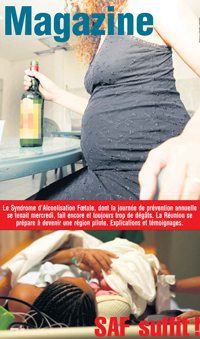THE HISTORY OF ALCOHOLIC FETOPATHIES (1997)
Paul Lemoine, MD Nantes, France
The effects of parental alcoholism on offspring outcome have been known since antiquity. Aristotle, Plutarch, and Diogenes describe it, and until the 19th century physicians continued to confirm these impressions. It is likely that they were doing so based on precise observations. Unfortunately, two errors have persisted throughout time. Curiously, very often, paternal alcoholism was blamed, undoubtedly because it is more evident and more easily admitted, whereas aternal alcoholism is considered shameful and voluntarily hidden. Also, exaggerations led to accusing alcohol for many unidentified physical and psychological anomalies.
In the 19th century, medical progress allowed the precise identification of some of these syndromes, and more precise studies showed that alcoholic mothers could give birth to seemingly normal children (which can clearly be observed when alcohol consumption is recent). Shifting from one extreme to the other, it was then taught that parental alcoholism had no effect on the offspring. For a while, syphilis was also dealt with in a similarly exaggerated manner. In children, in addition to the well-defined congenital syphilis in newborns of mothers with clinical syphilis, some physicians were spreading the myth of « heredosyphilis », suggesting that syphilis could be hereditary.
It is interesting to note that under this false nomenclature of « heredosyphilis », solid clinicians had described a well-defined syndrome in the newborn. The syndrome included significant hypotrophy and microcephaly, as well as a unique facial dysmorphology with a severe saddle shaped nose that some wanted to attribute to a possible syphilitic « chondritis » which might have collapsed the nose’s cartilage during pregnancy. It appears most likely to me that they were simply describing alcoholic fetopathies. As syphilis often concurred with alcoholism, they were able to observe this syndrome in some infants who had past history suggestive of syphilis, omitting the possibilities of alcoholism, since alcohol was believed to be non-teratogenic.
During my medical studies starting in 1935,
we certainly observed some rare cases of congenital syphilis. « Heredosyphilis » was sometimes suggested by parents of abnormal children, looking to defer the responsibility to possible syphilis in the grandparents (preferably the in-laws!). Within the faculty, the description of « heredosyphilis » appeared in old texts, and our professors rarely mentioned it. If they did, more often than not, it was to reject its existence. As for parental alcoholism, we were taught without any doubt that it had no teratogenic effects, although sometimes written with a caution against conception while intoxicated.
Around 1960, two French studies independently proved for the first time the true dangers of alcohol use in pregnant women. The two studies had totally different starting points. The first was Jaqueline Rouquette’s thesis entitled « Influences of the parental alcoholic intoxication on the physical and psychological development of young children » (Paris 1957). This work directly involved the study of children of alcoholics at the Paul Parquet Children’s Hospital. Dr. Rouquette studied 100 children with confirmed parental alcoholism (either paternal, maternal or both).She observed effects on the children, especially with maternal alcoholism, and she presented in some of them a clear description of alcoholic fetopathies as they are known today. This thesis appears to have been ignored– a fact that surprised me when I later discovered it while preparing a bibliography.
The second study, by me, started with no preconceived thoughts about alcoholism. It was while researching the cause of a strange dystrophy seen in certain children that I discovered alcoholism in their mothers. At that time I was Chief of the Pediatric Service at the Centre Hospitalier Universitaire (CHU) in Nantes where I spent 4 hours each day examining children and their parents. In addition, I was responsible for the public assistance’s nursery where I personally assessed all the children who were admitted. I was usually called to the two maternity wards of the hospital when a child presented with some problem, as there was no systematic assessment of all newborns at that time. I was also attending the Civeliere Nursery, home to 40 very hypotrophic babies and children coming in from the local area, as well as from outlying districts. I therefore saw a substantial number of newborns with serious anomalies each day.
Around 1960, I was struck by the existence of a yet unknown syndrome among these children. The syndrome included severe intrauterine growth retardation resulting insignificant and lasting hypotrophy, microcephaly, psychomotor retardation with behavioural problems (particularly great instability), very specific facial dysmorphology with depressed nasal bridge, and frequent malformations (especially cardiac and skeletal). The children all looked as if they were siblings! They obviously had a well defined syndrome, unknown to me. This evoked old memories of the so-called « heredopsyphilis » I even checked some serologies, which were negative.
I then reviewed numerous books and consulted colleagues, showing them these subjects and their photographs, with no success. Other pediatricians were referring cases to me at La Civeliere as a last resort with a diagnosis of « adverse neonatal effects with unidentified cause », in the hope that tender loving care might be of benefit to them. One day, in one of La Civeliere’s wards, I was comparing two of these children looking for an answer, and while talking to the staff as I always did, one of them responsible for the two children indicated to me that both of their mothers were heavily alcohol dependent. And the spark hit!
Could the notion of alcohol as a nonteratogen be false?
I looked back at all my files and conducted in depth inquiries. All of the children marked by this syndrome had alcoholic mothers! I was rapidly convinced. It proved more difficult to convince my colleagues. In March 1964, I reported finding in 15 children, « effects of maternal alcoholism in the offspring » to the Medical-Surgical Society of Nantes Hospitals with no great response. Not combative enough, I retreated to simply teaching those facts to my students who were easily convinced by the precise examples they referred to as « the Lemoine kids. » I continued my investigations.
This is an amusing fact :
the 127 cases of a modest pediatrician from Brittany did not create any interest, where as 8 American cases became immediately convincing and the syndrome became rapidly known in France and in the whole world. Thanks go to Smith for being able to impose the existence of this reality and its dramatic consequences. Publications rapidly multiplied and the topic was the subject of the French Pediatric Congress in Paris in 1984. I had diagnosed personally 300 cases and I had found some of them at an adult age. I therefore offered my services but never received a positive response.
I received a letter from Canada announcing that an international jury had granted me the 1985 Jellinek Prize which I received in Calgary during the 34th International Congress on Alcohol and Toxicology. For a long time, I had wanted to know the outcome of the children I had diagnosed originally. I first tried to contact the parents and sent 60 letters without any reference to alcohol, but did not receive a single response. Later on, I contacted the doctors and social services. For the 150 oldest files, I sent a letter to each doctor and social service where we had placed the children after their release from our hospital or La Civeliere. From 300 letters, I received 14 replies all telling me that the child’s whereabouts had been lost! The only solution left was to personally go to the establishments for the handicapped where I was sure to find some of them. But that was impossible for me to do while I was still practicing.
As soon as I retired, I undertook this task. The first ones found were all severely debilitated, which was easily explained by the category of the targeted establishments. This follow-up could not be of value unless I could find all of the individuals of a given group, thus avoiding selection bias. Hence, among my cases of fetopathy, I compiled the list of all those who had reached 18 years of age and were born in Loire Atlantique, so I could have some chance of finding them. I then embarked upon the task of finding them all, searching in the Loire Atlantique and some peripheral areas.
I searched in all the establishments, agencies and organizations in charge of housing, employing or placing the handicapped. In all, I contacted close to one hundred establishments. It did not mean a few months of work as I had planned at first, but rather ended up taking years, hundreds of letters, phone calls and thousands of kilometers of travel. I succeeded. I located all of the 50 Papotiere cases, that were the most severe, as I was always well received by the directors and the doctors in these establishments. I was missing two individuals, and so I visited the local registry in their places of birth. One was from Saint Nazaire where I found out that he had died at a young age. The other was from Nantes where I learned that though he was alive, he was a gypsy and difficult to locate.
I also succeeded in two-thirds of the other cases, though I was slowed down by two major organizations that should have been especially interested in my work. Retreating behind professional confidentiality, they refused to show me their files. It seemed ironic that they did not have the right to reveal a diagnosis that I had myself established 20 years earlier! Among the 105 fetopathies seen again at an adult age I observed that:
1. the facial dysmorphy had changed, often with a large nose and large chin (contrary to the newborn);
2. the statural and ponderal hypotrophy were attenuated;
3. the microcephaly persisted significantly(between 2-6 standard deviations);
4. the intellectual deficits persisted, as did the maladaptive behaviour.
An important finding has struck and worried me most — 14 offspring of alcoholic mothers, considered normal at birth with no visible facial dysmorphy, have been found as adults to have the same psychological problems and maladaptive behaviour. They also exhibit a slight trend toward microcephaly (-1 or -2 standard deviation). None had reached the average adult head circumference.
Written by Paul Lemoine in French in 1997.
This paper was translated by Yvette Navioz and
Ibrahim Fayez.



